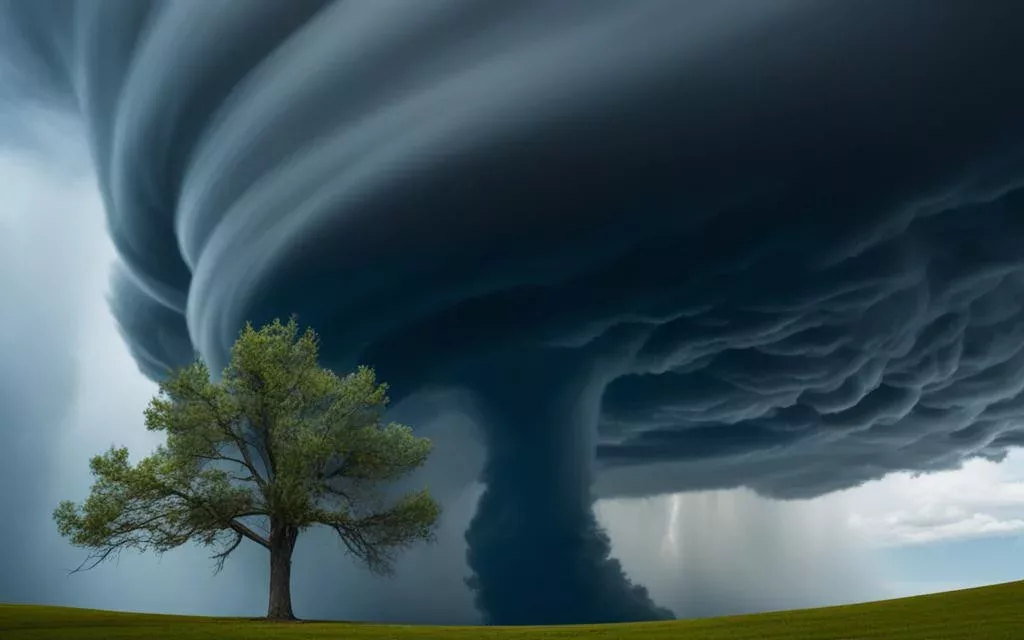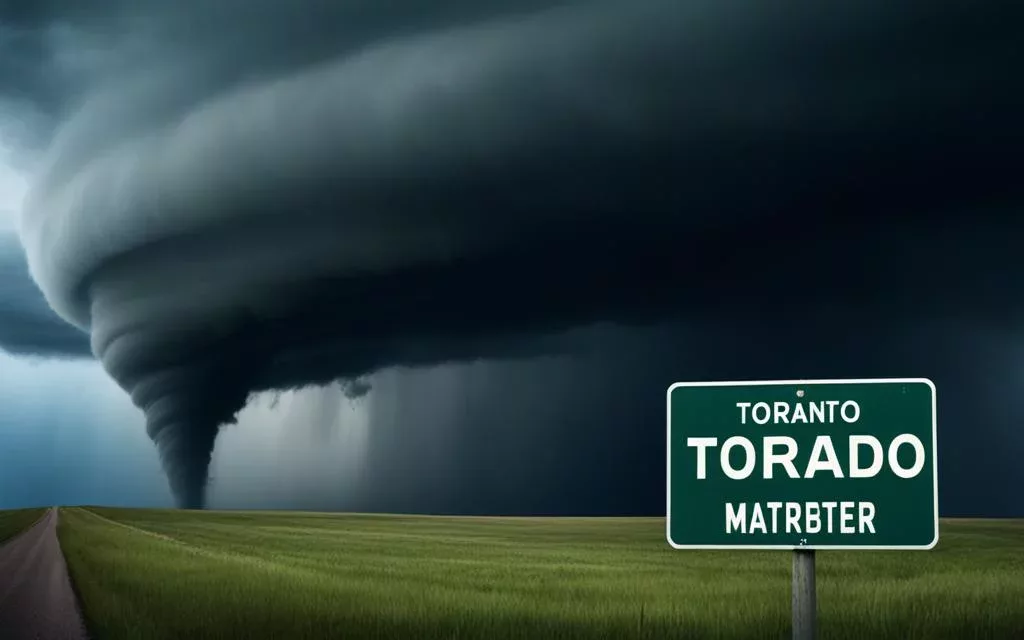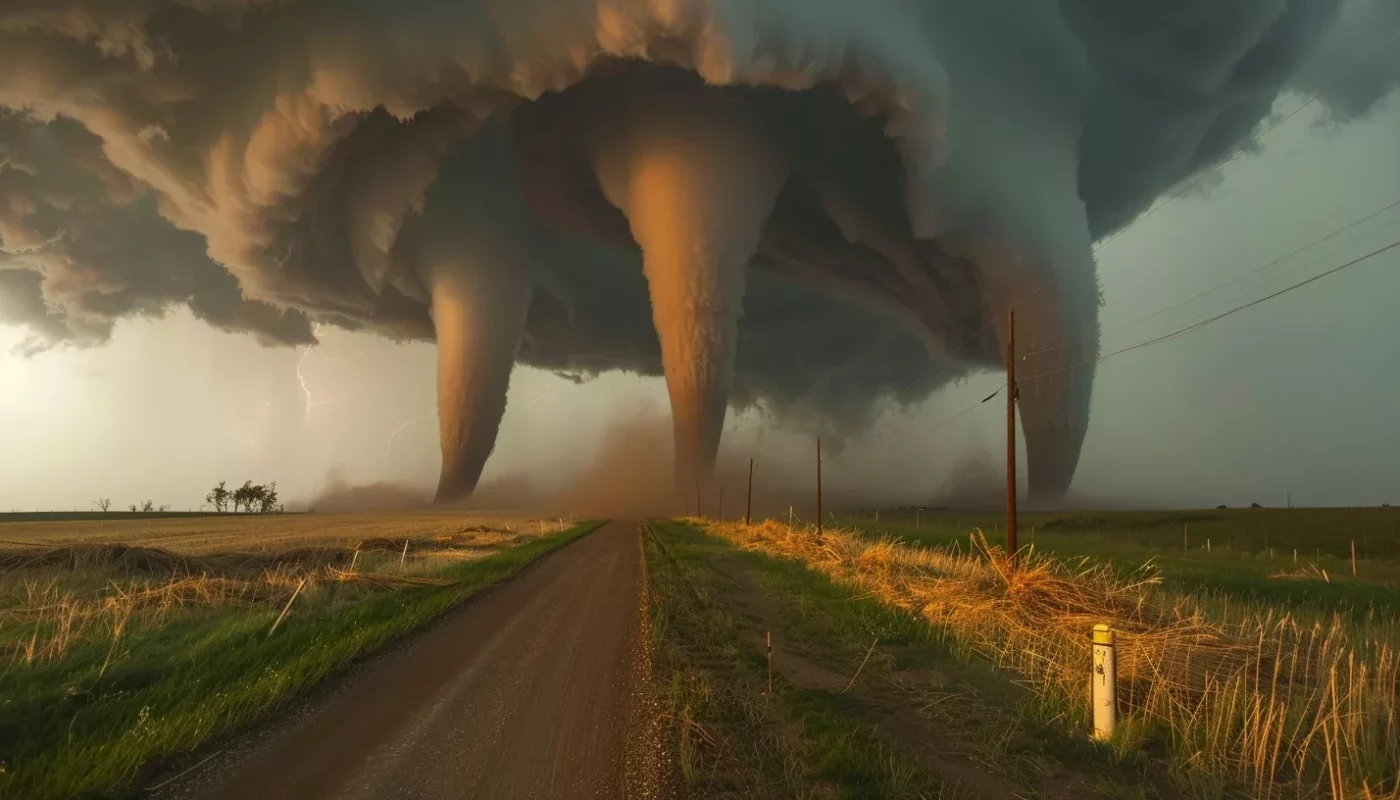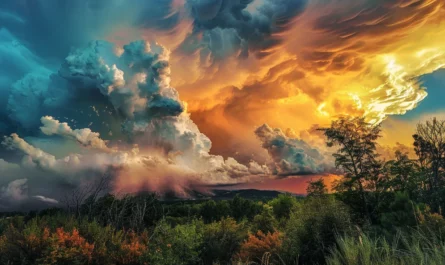Tornadoes are awe-inspiring and can have winds up to 300 miles per hour. They can wreak havoc, posing a serious threat to lives and property. In exploring tornadoes, we’ll uncover the science and safety strategies to handle these storms.
The Anatomy of a Tornado
Tornadoes are both fascinating and dangerous. They grab our attention and fill us with wonder. Learning about how tornadoes are formed helps us understand their power.
A tornado’s funnel cloud is iconic. This shape forms when warm, moist air meets cold air. This clash causes the air to spin vertically, creating the tornado’s look.
Inside this twister, winds can get extremely fast. The power of a tornado comes from this high-speed spin. Some tornadoes have winds that go beyond hundreds of miles per hour. Their force can destroy almost anything.
“The spinning funnel of a tornado is a fearsome sight to behold. The whipping winds and vortex of destruction make it one of the most powerful forces in nature.”
Tornadoes can knock down trees, destroy buildings, and throw debris far and wide. It’s crucial to respect their power and stay safe.
https://www.youtube.com/watch?v=ul6Sdh6cAw8
| Key Elements of a Tornado | Description |
|---|---|
| Funnel Clouds | The distinctive funnel-shaped cloud that extends from the base of a tornado. |
| Wind Speed | The rapid rotation generates wind speeds that can exceed hundreds of miles per hour. |
| Rotation | The spinning motion within the tornado’s vortex, creating a powerful force of destruction. |
| Destructive Force | The intense wind speed combined with rotational power results in severe damage. |
For experts and those at risk, knowing about tornadoes is key. We need to understand their anatomy to prepare and protect ourselves. By knowing about funnel clouds, wind speed, and their rotation, we can lessen the damage tornadoes cause.
Tornado Formation and Types
Tornadoes are typically formed in severe thunderstorms called supercells. These supercells have the right conditions for tornadoes to develop. They need wind shear and instability. This mix creates a perfect storm for tornadoes.
Supercells are big, strong thunderstorms with a rotating updraft, called a mesocyclone. Wind shear affects the wind direction and speed at different heights. It makes the updraft spin, which is crucial for tornado formation.
When a supercell and the right conditions are present, a tornado can start forming. It begins with a funnel cloud. If the funnel cloud touches the ground, it becomes a tornado.
Tornadoes vary based on where they form. Waterspouts form over water bodies like oceans, lakes, or rivers. They’re tied to severe thunderstorms or tropical cyclones. You can see a funnel from the water to the storm cloud.
Landspouts form over land and differ from waterspouts. They don’t come from supercells but from intense updrafts starting at ground level. Even though they’re usually weaker than supercell tornadoes, they can still be dangerous.
“Tornadoes are natural phenomena that are typically formed within severe thunderstorms known as supercells.”
Types of Tornadoes:
1. Supercell Tornadoes: The most common and destructive kind. They come from supercell storms. These tornadoes spin intensely and cause most tornado deaths.
2. Waterspouts: These tornadoes occur over water when warm, moist air rises fast. They pose risks to boaters and those near beaches.
3. Landspouts: Landspouts form over land without a supercell. They can be smaller and weaker but still harmful. They relate to severe thunderstorms or extreme heat.
Knowing about different tornado types helps with forecasting and safety plans. By understanding the weather conditions for tornadoes, forecasters can predict their occurrence. This gives people time to take safety measures.
| Tornado Type | Description |
|---|---|
| Supercell Tornadoes | Tornadoes that develop within supercell thunderstorms. |
| Waterspouts | Tornadoes that form over bodies of water. |
| Landspouts | Tornadoes that form over land without a supercell. |

Tornado Damage and Destruction
Tornadoes can cause huge damage. They use the Enhanced Fujita (EF) scale to show how bad the damage is. This scale goes from EF0 (least bad) to EF5 (worst), based on the damage seen and wind speed.
When a tornado hits, it can pull trees out of the ground, destroy buildings, and leave a mess of debris. This debris comes from things it broke and stuff from nature, making a dangerous mix.
Let’s look at the EF scale and the kinds of damage tornadoes can do:
Enhanced Fujita (EF) Scale
The EF scale measures tornado strength by the damage caused. It looks at what kind of buildings were hit, how much they were damaged, and the wind speeds. The scale starts at EF0 and goes to EF5, with each step showing more destruction.
| EF Scale Category | Estimated Wind Speed | Typical Damage |
|---|---|---|
| EF0 | 65-85 mph | Minimal to no structural damage |
| EF1 | 86-110 mph | Light to moderate damage: Roof, windows, and doors may be damaged or destroyed. |
| EF2 | 111-135 mph | Considerable damage: Roofs may be torn off, mobile homes may be completely destroyed, and trees may be uprooted. |
| EF3 | 136-165 mph | Severe damage: Well-built houses may experience significant damage, large trees may be snapped or uprooted, and cars can be flipped. |
| EF4 | 166-200 mph | Devastating damage: Well-built houses are leveled, debris is scattered for long distances, and cars can be thrown considerable distances. |
| EF5 | Over 200 mph | Incredible damage: Strong, well-built structures can be swept away, cars can become projectiles, and the landscape can be altered. |
Tornadoes can also mess up power lines, roads, and other key setups. Their impact can last a long time, needing a big cleanup and recovery.
Knowing how destructive tornadoes can be is key. With strong building rules, tornado-safe buildings, and early warnings, we can lessen their harm and keep communities safe.
Tornado Safety Measures
When a tornado warning comes, your and your loved ones’ safety matters most. Act fast and follow safety steps to stay safe during a tornado. Here are key tips for tornado safety:
- Seek shelter in a designated storm shelter: Immediately head to a tornado shelter if you can. These are built to handle tornadoes and are the safest option.
- Use a small, windowless interior room: Without a storm shelter, find a small, inside room without windows, like a basement, bathroom, or closet. It should be on the ground floor.
- Have an emergency kit ready: Get an emergency kit together with important items like food that won’t spoil, water, flashlights, batteries, a first aid kit, and any needed medications. Keep it where you can get to it fast.
- Create an evacuation plan: Make an evacuation plan with those you live with. Pick a safe spot to meet outside your home, figure out how to stay in touch, and know where to go if you need to leave.
Emergency Kit Checklist:
Make sure your emergency kit has:
- Non-perishable food (for at least three days)
- Bottled water (one gallon per person each day)
- Flashlights and extra batteries
- First aid kit
- Needed prescription medications
- Items for personal cleanliness
- Cash and key documents
- Cell phone charger
Being ready and having a plan can hugely impact your safety in a tornado. Keep up with tornado warnings, make sure you have what you need for emergencies, and practice drills with your family. This will help everyone know what to do if a tornado happens.

Tornado Preparedness for Schools and Communities
Schools and communities are crucial in keeping everyone safe during tornadoes. It’s vital to have plans for tornado preparedness. These plans help avoid injuries and ensure a quick response and recovery. Schools and communities should focus on education, communication, and finding safe places.
Educating Students: Tornado Drills and Safety Procedures
Conducting tornado drills in schools is very important. These drills teach students and staff how to stay safe during a tornado. By learning to seek shelter quickly, everyone can be safer. This reduces risks if a tornado actually happens.
Establishing Clear Communication Channels
When a tornado hits, talking clearly and efficiently matters a lot. Schools and communities should use many ways to share information. This includes alert systems, social media, and local news updates. Clear instructions help everyone make smart choices for safety.
Identifying Safe Rooms or Shelters
Choosing safe rooms or shelters is key for tornado protection. These places must be strong, easy to get to, and ready for everyone. It’s also crucial to keep these areas well-maintained. They should be checked often to ensure they are safe.
Communities should also work with local groups to point out shelters. This helps those without a personal safe spot know where to go. Telling everyone about these shelters is a must for community safety.
Community Response and Support
After a tornado, supporting each other is vital. This includes volunteering, donations, and helping tornado victims. Working with local emergency teams makes recovery efforts stronger. By coming together, communities can bounce back faster.
With good planning, drills, communication, and community effort, we can face tornadoes stronger. These steps save lives. They make sure schools and communities are ready for tornadoes.
Tornado Forecasting and Prediction
Forecasting tornadoes is crucial for keeping communities safe. Meteorologists use Doppler radar to monitor weather that could cause tornadoes. This technology helps them track storm conditions closely.
The NOAA Storm Prediction Center (SPC) issues daily forecasts for severe thunderstorms in the U.S. These forecasts rely on weather observations and models. They give insights into how likely tornadoes are to form.
Severe thunderstorm or tornado watches last 4 to 6 hours. They are issued when tornado conditions are possible. These watches alert people to be ready for bad weather.
Local National Weather Service (NWS) offices issue tornado warnings. These are based on actual sightings or radar signs of tornadoes. Using high-resolution radars with computer models helps predict storms better. This leads to quicker warnings.
The National Severe Storms Laboratory (NSSL) works with the SPC and NWS during the NOAA Hazardous Weather Testbed. This work happens in spring. It helps improve how we forecast tornadoes.
Storm chasers are important for tornado forecasting too. They provide live data from inside storms. This helps us understand tornado behavior better.
Forecasters use ensemble forecasting to improve accuracy. This method runs many weather prediction models at once. It looks at different outcomes to make better tornado predictions.
The Warn-on-Forecast program aims to give quicker tornado warnings. It uses computer forecasts to warn people earlier. This gives everyone more time to get to safety.
Thanks to better technology like Doppler radar, tornado forecasting has gotten much better. Forecasters working together have made big improvements. Now, people have more time to prepare for tornadoes.
Tornado Climate and Frequency
Tornado Alley and Dixie Alley are well-known in the United States for their high tornado rates. Tornado Alley is in the central U.S., covering states like Texas and Kansas. Dixie Alley includes the southeastern states, such as Alabama and Tennessee. These areas see more tornadoes than most other places.
Tornadoes often happen in the spring and early summer. This is when warm air from the Gulf of Mexico meets cold air from the Rockies. The mix creates ideal conditions for tornadoes. But remember, tornadoes can happen any time of the year.
Scientists are studying how climate change might influence tornadoes. They think climate change could make weather patterns shift. This might lead to more intense tornadoes. Warmer temperatures and more moisture in the air could make thunderstorms more severe.
“Tornado Alley and Dixie Alley are home to some of the most devastating tornadoes in history. Understanding the climate and frequency of tornadoes in these regions is crucial for preparedness and safety.”
The Tornadoes of Tornado Alley
Tornado Alley is a hotspot for tornadoes in the U.S. It stretches from Texas to Nebraska. Here, warm and cold air masses collide. This mix is perfect for creating tornadoes.
The area’s geography plays a big role. The flat land helps wind flow easily, leading to strong thunderstorms and tornadoes. A warm front in the area also increases severe weather chances.
Dixie Alley has lots of tornadoes too. It’s in the southeastern U.S., covering states like Alabama. The same air mass collision happens here. This results in unstable conditions and frequent tornadoes.
“Tornado Alley and Dixie Alley draw attention due to their heightened tornado activity. These regions demand diligent preparedness and a thorough understanding of tornado climate and frequency.”
The Impact of Climate Change
Climate change might affect tornadoes, but it’s complex. Scientists are exploring how it may change tornado trends. Warm temperatures could make thunderstorms more intense and frequent.
Factors like wind patterns also play a role in tornado formation. Climate change could alter these elements. This makes studying the climate-tornado link important for future predictions.
Digging into history and climate models helps scientists. They’re trying to see how changing climates might change tornado behavior. It’s key for better understanding and preparedness.
“Continued research and analysis are needed to comprehensively understand the relationship between climate change and tornado activity. This knowledge will aid in developing effective strategies for tornado preparedness and risk mitigation.”
Tornado Conservation Efforts
Tornadoes can cause a lot of harm to places where people live. They also harm the environment. To fight these powerful storms, we work hard to lessen the damage they do. We also aim for long-lasting ways to keep the earth safe.
To cut down the damage from tornadoes, we improve how buildings are made. We make rules tougher. This makes sure new buildings and upgrades can stand up to tornadoes. We focus on making roofs, walls, and foundations stronger. This can fight off strong winds and flying debris. Thanks to these steps, we can keep people and their properties safer.
But fixing tornado damage isn’t only about buildings. After a tornado, we work to fix the environment too. Cleaning up debris is important. It helps places get back to how they were before the storm. We also plant trees again, fix broken stuff, and help nature heal. Doing these things helps communities bounce back stronger.
| Efforts for Tornado Conservation | Impact |
|---|---|
| Improvement of building codes | Reduces structural damage and protects lives |
| Environmental restoration and cleanup | Minimizes the impact on ecosystems and promotes resilience |
Building codes are key in fighting tornado damage. Stronger building rules mean less damage from winds and debris. They keep people safe and save our buildings. This quote is from the National Oceanic and Atmospheric Administration (NOAA). source
It’s very important to work on tornado conservation. It reduces harm and helps communities stay strong. By making buildings better and fixing nature, we fight tornado damage. We’re always researching and finding new ways to stay safe. Engaging with the community helps too. Together, we’re getting better at dealing with tornadoes. We aim to keep our world safe for the future.
The Science Behind Tornadoes
Scientists study tornadoes closely to learn how they form and act. They use research and analysis to look into tornadoes, covering atmospheric dynamics, vortex theory, and more. This work is key to learning more and predicting tornadoes better.
When studying atmospheric dynamics, scientists look at how different elements in the Earth’s atmosphere interact. They check air pressure, temperature differences, wind patterns, and moisture. This helps them figure out what conditions lead to tornadoes.
The vortex theory is a big part of understanding tornadoes. It’s about the spinning motion tornadoes have. Researchers look into fluid dynamics and how vortexes form. This helps them know the forces inside these strong storms.
Numerical modeling is also crucial in studying tornadoes. Scientists use computer simulations to mimic tornadoes. This helps forecast how they move and how strong they might be. It’s a big help in predicting and understanding tornadoes.
Scientists use many methods and tools to learn more about tornadoes. Their findings help predict tornadoes better. This way, communities can prepare and respond to these dangerous weather events more effectively.
Conclusion
Tornadoes are both awe-inspiring and devastating. They have huge power and can destroy a lot and cause deaths. But, if we understand them and know how to stay safe, we can lessen their damage.
Knowing about tornadoes and their risks is vital. We have to follow safety steps like using storm shelters, having an emergency kit, and making an evacuation plan. Doing these things helps us stay safe.
We also need to work on reducing the effects of tornado damage. This includes better building codes and stronger structures. It helps communities recover faster and stay resilient.
To sum up, knowing and being ready for tornadoes is essential. By being informed, staying safe, and supporting efforts to lessen damage, we can protect our communities from extreme weather.




